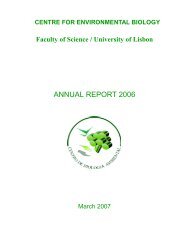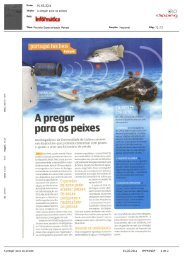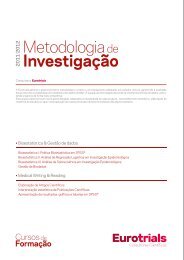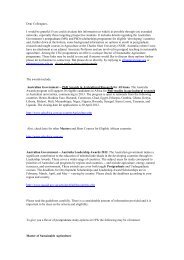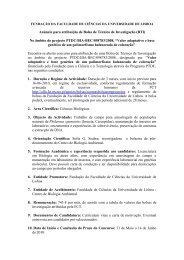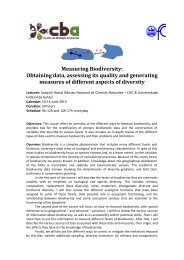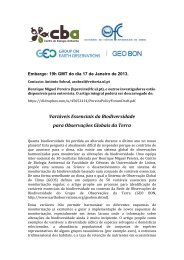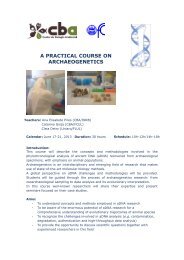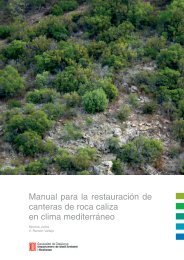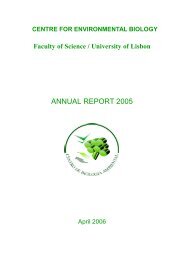European Red List of Vascular Plants - European Commission
European Red List of Vascular Plants - European Commission
European Red List of Vascular Plants - European Commission
Create successful ePaper yourself
Turn your PDF publications into a flip-book with our unique Google optimized e-Paper software.
more than 16% <strong>of</strong> threatened species), an increase<br />
in fire frequency or intensity (or sometimes also fire<br />
suppression), severe weather events, such as drought and<br />
flooding, and intensive forestry (including pollutants<br />
from forestry activities).<br />
Although Figure 17 shows intensified livestock farming<br />
as the most widespread threat to CWR species, if the<br />
proportion <strong>of</strong> threatened to non-threatened species is<br />
considered, only 29% <strong>of</strong> CWR impacted by livestock<br />
farming are assessed as threatened. The opposite is the case<br />
for the impact <strong>of</strong> alien invasive species on CWR, where<br />
66% <strong>of</strong> species impacted are threatened. This may lead to<br />
the conclusion that in Europe alien invasive species are<br />
a more pernicious threat to CWR species than livestock<br />
farming; however, this result has to be interpreted with<br />
care. Firstly, overall more threatened and Near Threatened<br />
species are affected by intensified livestock farming (32<br />
species) than by invasive species (21 species). Secondly,<br />
many species are affected by more than one threat and it<br />
might be a certain combination <strong>of</strong> threats that increases<br />
the species’ risk <strong>of</strong> extinction. These potential cumulative<br />
effects have not been analysed. Further, the <strong>Red</strong> <strong>List</strong><br />
assessments are only a measure <strong>of</strong> the threatened status <strong>of</strong><br />
species as entities (i.e., taxonomic diversity), not <strong>of</strong> intraspecific<br />
diversity. Livestock farming and indeed many<br />
<strong>of</strong> the other threats impacting CWR could be causing<br />
significant levels <strong>of</strong> genetic erosion; however, without<br />
regular and long-term monitoring <strong>of</strong> genetic diversity<br />
within and between a broad range <strong>of</strong> CWR species, we<br />
cannot make any supported assumptions.<br />
Climate change is also a significant threatening factor<br />
for CWR species. It is predicted to increase average<br />
temperatures by 2–4°C over the next 50 years and cause<br />
considerable changes in regional and seasonal patterns <strong>of</strong><br />
precipitation (IPCC 2007). Within Europe, Thuiller et<br />
al. (2005) predict that by 2080 climate change will result<br />
in a 27–42% loss <strong>of</strong> species, with potential extremes<br />
ranging from 2.5–86% loss <strong>of</strong> current floristic diversity.<br />
There have been few studies <strong>of</strong> the likely impact on<br />
CWR diversity; however, Jarvis et al. (2008) undertook<br />
a comparative study <strong>of</strong> three crop gene pools – Arachis,<br />
Solanum and Vigna – and compared current distribution<br />
Beta patula is a primary wild relative <strong>of</strong> cultivated beets and is an important gene source for enhancing drought and virus resistance. It is endemic to two small, uninhabited islets in<br />
the Madeira archipelago – Ilhéu do Desembarcadouro and Ilhéu Chão – where it grows in dry, rocky places by the sea. It is threatened by invasive alien species, rabbit grazing and an<br />
increase in the seagull population, and is globally assessed as Critically Endangered. B. patula is listed in Annex II <strong>of</strong> the EU Habitats Directive and the islands on which it occurs are<br />
part <strong>of</strong> the Parque Natural da Madeira which is designated as a Special Area <strong>of</strong> Conservation (SAC) and Special Protected Area (SPA); however, special management measures are needed<br />
to ensure the survival <strong>of</strong> this species. Photograph © Brian Ford-Lloyd.<br />
31



